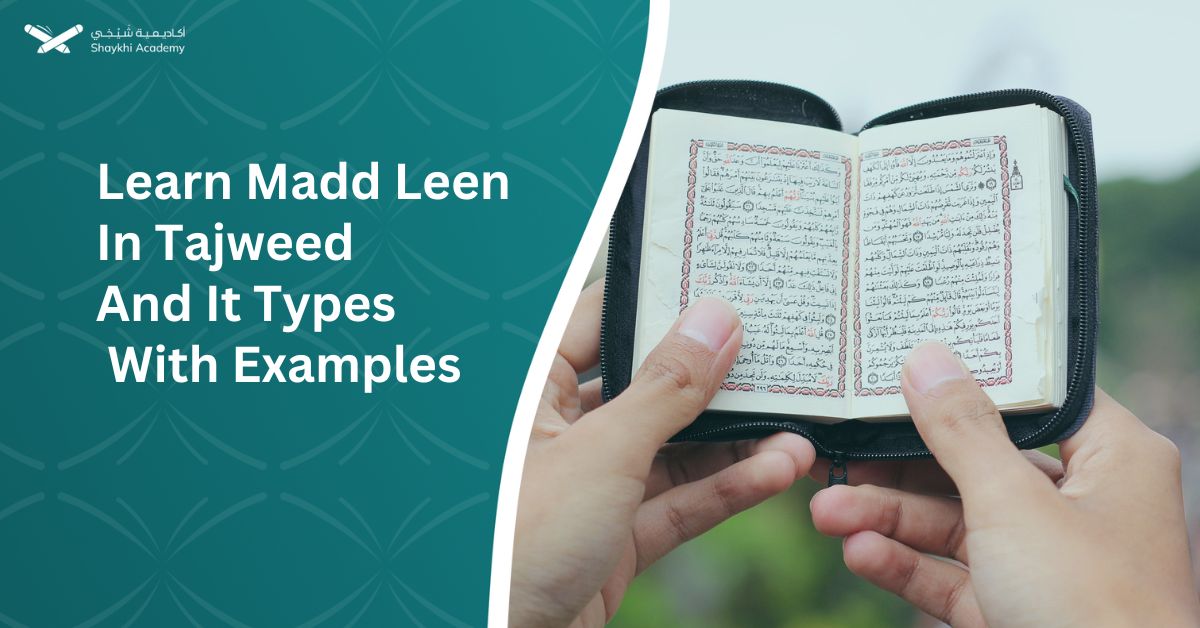Madd Leen in Tajweed involves soft prolongation occurring when a word ends with a “yaa” or “waaw” with a sukoon after a preceding letter with a fatha, due to a casual pause in recitation. It ensures smooth pronunciation without an original sukoon, distinguished from Natural Madd (Al-Madd al-Tabee’ee) by its specific application during pauses in Quranic recitation.
Learning Tajweed is your bridge to mastering your Arabic language and reciting the Holy Qur’an accurately, which is the ultimate goal.
Therefore, today we discuss one of the most important types of Madd (Prolongation), which is Madd Leen (meaning Soft prolongation or extension).
What is Madd Leen? Why is it called so? What are its letters? A strange fact that will make Madd Leen disappear from your recitation!
How can we differentiate between it and other types of Madd? How to pronounce it?
All these questions and more will be discussed in this article, let’s go!
What is Madd Leen?
Madd Leen is the Madd that occurs when a letter of Leen appears before the last letter which is Saakin. This Sukoon is not original But occurs due to the casual pause of recitation.
What are The Letters of Leen?
Madd Leen has only 2 letters, They are: waaw saakinah (وْ) and yaa saakinah (يْ) both preceded by a letter with fatha ( َ ).
Why is it Called “Madd Leen”?
Madd Leen is called with this name because its meaning in Arabic is “Soft Prolongation or Lengthening”. This softness is due the ease and smoothness with which the Leen letters are pronounced.
The condition of Applying Madd Leen
Madd Leen occurs only when you pause on a word that contains a “yaa” with Sukoon or a “waw” with Sukoon on the pre-last letter, (in which the last letter is Saakin due to Pausing recitation casually).
How can I differentiate between the Natural Madd (Al-Madd al-Tabee’ee) and Madd Leen?
There is a main sign that can ensure you won’t be confused between the Natural Madd and Madd Leen:
The Natural Madd comes when alif (ا) can be prolonged when it’s preceded by fatha( َ ), waaw (و) can be prolonged when it’s preceded by Dammah ( ُ ) and yaa (ي) can be prolonged when it’s preceded by kasrah ( ِ ).
The 3 Types of Natural Madd are grouped together in the word (نُـوحِـيــهَـا).
As we can see, the first syllable is the elongation of the Madd Waw “نُـو” and is pronounced “Noo”. The second syllable is the Madd Yaa “حِيـ” and is pronounced “Hee”. The third syllable is the Madd Alif “ـهَـا” and is pronounced “Haa”.
What are the similarities and the differences between Madd ‘Aridh and Madd Leen?
The similarities are:
1- Both of them occur due to Pausing on a word through or at the end of the Verse.
2- The time of Madd pronunciation: The estimated time of Madd ‘Aridh is around 2,4,6 Counts. But the estimated time of Madd Leen is around 2,4,6 Counts.
But the difference is Due to many reason for example:
- The Type of the Madd of the Pre-Last letter
- Madd ‘Aridh occurs when an occasional Pause comes after a natural Madd of Alif or Waaw or Yaa like(يَشَاءُ) ,( ٱلۡبُرُوجِ ) ,(ٱلۡعَٰلَمِينَ)
- While Madd Leen occurs when you pause on a word on which a “yaa” Saakinah or a “waaw” Saakinah is the pre-last letter
So Let’s learn some examples that will help you understand more deeply.
How to pronounce Madd Leen?
Surat (Quraysh) has many easy examples of Madd Leen if we pause at the end of each Verse.
So let’s learn how to pronounce the last word of Each Verse:
Verse 1: ﴾لِإِيلَافِ قُرَيْشٍ ﴿
In case you connect Verse 1 to Verse 2 you’ll pronounce it as: (Li’īlāfi Qurayshin) due to the Tanween on Sheen letter.
But if you stop at “قُرَيْشٍ” you’ll apply Madd Leen on Yaa Saakina and so you pronounce it as “ Quraysh” due to occasional Sukoon on sheen letter.
Verse 2: ﴾إِيلَافِهِمْ رِحْلَةَ الشِّتَاءِ وَالصَّيْفِ ﴿
In case you connect Verse 2 to Verse 3 you’ll pronounce: (2 ‘Īlāfihim Riĥlata Ash-Shitā’i Wa Aş-Şayfi) due to Kasra on Faa letter.
But if you stop at “وَالصَّيْفِ” you’ll apply Madd Leen on Yaa Saakina and so you pronounce it as “ Wa Aş-Şayf” due to occasional Sukoon on Faa letter.
Verse 3: ﴾ فَلْيَعْبُدُوا رَبَّ هَٰذَا الْبَيْتِ ﴿
In case you connect Verse 3 to Verse 4 you’ll pronounce: (Falya`budū Rabba Hādhā Al-Bayti) due to Kasra on Taa letter.
But if you stop at “الْبَيْتِ” you’ll apply Madd Leen on Yaa Saakina and so you pronounce it as “ Al-Bayt” due to occasional Sukoon on Taa Letter.
Try to apply Madd Leen on Verse 4 Before Continuing Reading.
Verse 4: ﴾ الَّذِي أَطْعَمَهُمْ مِنْ جُوعٍ وَآمَنَهُمْ مِنْ خَوْفٍ ﴿
In case you connect Verse 4 to Basmalah you’ll pronounce: (Al-Ladhī ‘Aţ`amahum Min Jū`in Wa ‘Āmanahum Min Khawfin) due to Tanween on Faa letter.
But if you stop at “خَوْفٍ” you’ll apply Madd Leen on Waaw Saakina and so you pronounce it as “Khawf” due to occasional Sukoon on Faa Letter.
How to learn Madd Leen Correctly?
You can learn Madd Leen Correctly if you follow these steps:
1- Listen to A specialist Shaykh’s Recitation.
This will help you understand the principles of Tajweed rules in general, The more you listen, the more perfect you become!
2- Practice More and More.
The more you Practice, The more perfect you become.
It’s better to practice under the Supervision of an expert in Tajweed to ba able to identify your mistakes.
3- Re-correct your mistakes.
When you recite in front of a specialist shaykh, will teach you the right pronunciation.
And that is what we do in our Online Qur’an Classes in shaykhi Website! We afford flexible schedules that fit your time and budget, So you can take your Classes anywhere, anytime!
Try one of our Online Qur’an Recitation & Online Tajweed Courses and Notice the difference before and after!
Join us now and try a free session through this link.
Unlock the Path to Quranic Mastery with Shaykhi Academy!
Are you seeking the finest Quranic education right from the comfort of your home? Look no further! Shaykhi Academy stands out as a premier online Quran learning platform, dedicated to providing exemplary education to both children and adults.
Why Choose Shaykhi Academy?
- Connect with highly qualified native tutors.
- Flexible scheduling to suit your busy lifestyle.
- Affordable classes tailored for all levels.
- Accessible from anywhere around the globe.
Discover Our Range of Courses:
- Arabic Noorani Qaida: Lay a solid foundation for Quranic studies.
- Online Quran Classes for Kids: Engaging lessons for lifelong learning.
- Tajweed Rules for Kids: Learn to recite with confidence.
- Quran Hifz for Kids: Step-by-step guidance to memorize the Quran.
- Quran for Adults: Introduce yourself to Quran reading and Tajweed rules.
- Online Arabic Courses: Master the language of the Quran.
- Islamic Studies: A wide range of topics related to Islam, including theology, law, Quranic studies, Hadith.
Don’t Miss Out on Your Chance to Excel!
Whether you’re a beginner or seeking advanced knowledge, Shaykhi Academy can guide you! Book your free trial now and make Ramadan 2024 your Quranic turning point!

Conclusion:
Madd Leen is a Tajweed rule where soft prolongation occurs when a “yaa” or “waaw” with a sukoon is preceded by a letter with a fatha, resulting from a casual pause in recitation. It enhances smooth pronunciation without an original sukoon.
To differentiate from Natural Madd (Al-Madd al-Tabee’ee), which extends alif, waaw, and yaa based on preceding vowel signs, Madd Leen applies specifically when pausing on words ending with “yaa” or “waaw” sukoon due to a casual pause.
To learn Madd Leen effectively, listening to expert recitations, practicing consistently, and receiving feedback are crucial. This method ensures correct application and mastery of Tajweed rules, fostering accurate Quranic recitation.
With these insights, mastering Madd Leen becomes straightforward, bridging your path to accurate Qur’anic recitation. Start the journey and perfect your recitation today!
Written By: Nouran Radwan

















































